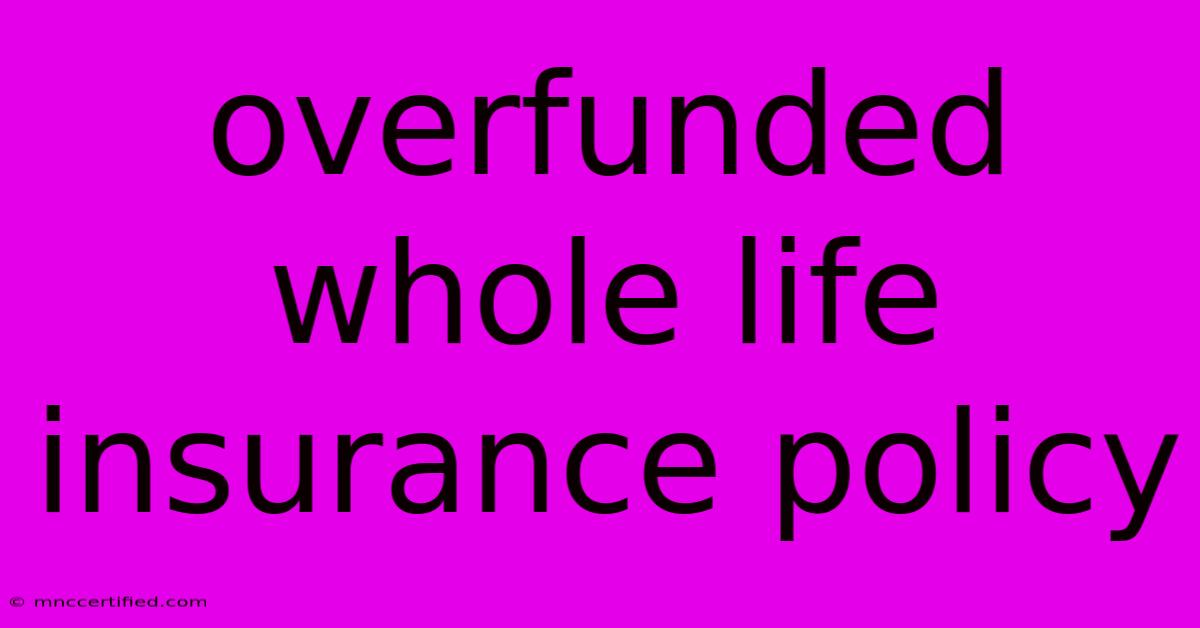Overfunded Whole Life Insurance Policy

Table of Contents
Overfunded Whole Life Insurance: A Powerful Tool or a Risky Investment?
Whole life insurance is a type of permanent life insurance that offers lifelong coverage and builds cash value. An overfunded whole life insurance policy takes this concept a step further by making significantly larger premium payments than the minimum required, aiming to accelerate cash value growth and potentially create a substantial financial asset.
While this strategy can offer attractive benefits, it's essential to understand its intricacies and potential drawbacks before making a decision. This article will explore the pros and cons of overfunding whole life insurance, examining its potential benefits and risks.
Benefits of Overfunding Whole Life Insurance
- Accelerated Cash Value Growth: Overfunding your policy leads to a faster accumulation of cash value, which you can access through loans or withdrawals.
- Tax-Deferred Growth: The cash value grows tax-deferred, meaning you won't pay taxes until you withdraw it.
- Potential for Long-Term Growth: Over time, the cash value in a whole life policy can accumulate significantly, potentially outpacing traditional investments.
- Guaranteed Death Benefit: The death benefit remains guaranteed, ensuring your beneficiaries receive a predetermined amount upon your passing.
- Loan Access: You can borrow against your cash value without affecting the death benefit, offering a flexible source of funds for emergencies or other needs.
Risks of Overfunding Whole Life Insurance
- High Premiums: Overfunding requires substantial premium payments, potentially straining your budget.
- Limited Flexibility: The policy's rigid structure may not be suitable for investors seeking greater control over their investments.
- Potential for Lower Returns: The cash value growth in a whole life policy may not match the returns of other investment options.
- Fees and Charges: Whole life insurance policies often come with high fees and charges, which can impact the overall return on investment.
- Potential for Misuse: The perceived safety of whole life insurance can lead to over-reliance on the policy, potentially delaying other financial planning initiatives.
Who Should Consider Overfunding Whole Life Insurance?
Overfunding whole life insurance might be a suitable option for:
- High-income earners: Individuals with a substantial disposable income may find the high premiums manageable.
- Long-term investors: The strategy can be effective for individuals with a long investment horizon, allowing the cash value to grow steadily over time.
- Those seeking guaranteed protection: Individuals seeking a guaranteed death benefit and a secure investment option may find whole life insurance attractive.
Alternatives to Overfunding Whole Life Insurance
- Term Life Insurance: Term life insurance offers a more affordable option for death benefit coverage, allowing you to allocate more resources to other investments.
- Index Universal Life (IUL): IUL policies offer cash value growth potential linked to a specific market index, potentially providing higher returns than traditional whole life.
- Traditional Investments: Diversifying your portfolio with stocks, bonds, and other assets can potentially generate higher returns than overfunding a whole life policy.
Final Thoughts
Overfunding whole life insurance can be a viable strategy for certain individuals, offering the potential for tax-deferred growth, guaranteed protection, and access to cash value. However, it's crucial to carefully consider the high premiums, limited flexibility, and potential for lower returns before making a decision.
Consult with a qualified financial advisor to determine if overfunding whole life insurance aligns with your individual financial goals, risk tolerance, and long-term investment strategy. Remember, informed decisions lead to greater financial success and peace of mind.

Thank you for visiting our website wich cover about Overfunded Whole Life Insurance Policy. We hope the information provided has been useful to you. Feel free to contact us if you have any questions or need further assistance. See you next time and dont miss to bookmark.
Featured Posts
-
Early Childhood Investment Corporation
Nov 09, 2024
-
Gladiator Ii Casts Paul Mescal Alongside Ridley Scott
Nov 09, 2024
-
Paris Olympics Horses To Receive Military Medals
Nov 09, 2024
-
Scrums Double Edge Blessing And Curse For Ireland
Nov 09, 2024
-
Girona Floods Spain Hit Again After Valencia
Nov 09, 2024